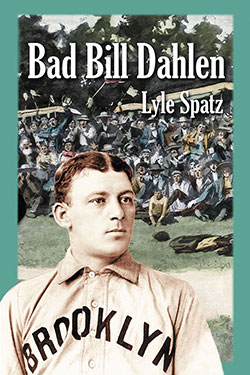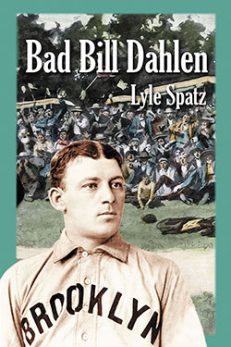Bad Bill Dahlen
The Rollicking Life and Times of an Early Baseball Star
$29.95
In stock
About the Book
He was often nonchalant and unfocused, showing up minutes before a game. He was rumored to get himself ejected so he could get to the racetrack. He was feisty, and abusive towards umpires even by today’s standards. And he’s among the best shortstops ever to play the game. “Bad Bill” Dahlen retired having played in more games than anyone in major league history; he was in the top ten for walks, extra base hits, RBI’s and stolen bases; and he led all shortstops in games, assists, putouts and double plays. He starred in both the 19th century and the deadball era, and managed as well. He’s a shoo-in for the Hall of Fame, right? Wrong. Player after player with lower career ratings has been admitted, yet Dahlen has been ignored. Maybe time has clouded memories of the brilliance of this offensive dynamo and master of his position—but how much longer can it be before Bad Bill Dahlen takes his rightful place in Cooperstown?
This examination of Bill Dahlen’s career as a player and manager highlights his strengths and weaknesses, personal and professional. Chronicling his achievements and placing him in context with the greats of all time, it makes a strong case that Bill Dahlen is a Hall of Fame shortstop, head and shoulders above many inductees. Seventeen chapters and 49 photographs trace his career; appendices compare his numbers to his Hall of Fame contemporaries, Hall of Fame shortstops, and list his lifetime batting and fielding statistics. Notes, a bibliography and an index are included.
About the Author(s)
Bibliographic Details
Lyle Spatz
Format: softcover (6 x 9)
Pages: 252
Bibliographic Info: 50 photos, tables, appendices, notes, bibliography, index
Copyright Date: 2004
pISBN: 978-0-7864-1978-4
eISBN: 978-0-7864-8434-8
Imprint: McFarland
Table of Contents
Acknowledgements vii
Introduction 1
1. From Nelliston to Chicago 3
2. The Best Young Player in the Game 8
3. A Record-Breaking Hitting Streak 23
4. “A Disorderly Element,” but Another Marvelous Season 34
5. The Captain Becomes Expendable 47
6. A Trade to Brooklyn Brings a Championship 60
7. One of the Great Teams of All Time 74
8. The American League Comes Calling 93
9. “It Has Always Been My Ambition to Play in New York City” 110
10. The Most Hated Team in Baseball 124
11. From “Bad Bill” to “Bill the Wizard” 136
12. The Giants Fade, and So Does Dahlen 149
13. Banished to Boston 160
14. Managing the Dodgers 170
15. Building a Contender. for Someone Else 184
16. The End of the Line 199
17. From Nelliston to Cooperstown 206
Appendix A: Bill Dahlen and His Hall of Fame Contemporaries 209
Appendix B: Bill Dahlen and Hall of Fame Shortstops 212
Appendix C: Bill Dahlen’s Lifetime Batting Statistics 217
Appendix D: Bill Dahlen’s Lifetime Fielding Statistics 219
Notes 221
Selected Bibliography 232
Index 235
Book Reviews & Awards
- “Comprehensive…meticulously researched…valuable…very well-researched…excellent read. Spatz’ book is distinguished by its strong writing and by its balanced and detailed coverage of Bill Dahlen’s extraordinary career”—SABR Deadball Committee Newsletter
- “Commendable”—Nine
- “Good read and recommended”—Nineteenth Century Notes
- “Rich detail about individual games and seasons…his stormy relationship with his first big league manager, Cap Anson of Chicago, is well recounted”—Little Falls Times
- “Spatz’s story recalls the career of an interesting player in brisk narrative fashion and with a sure-handed command of the facts. … A good read and recommended”— Bill Lamb, Newsletter of SABR’s Nineteenth Century Committee





